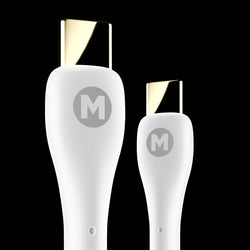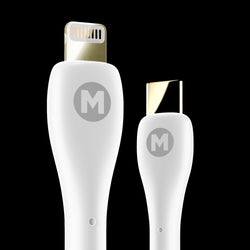
Everything You Need to Know About USB-C Technology
USB-C has become one of the most prevalent connection types, almost becoming a universal standard. USB-C ports are present on all types of devices, from laptops to smartphones, power banks and external hard drives. But why is USB-C so common? How does it work? And what is it used for? Our guide to USB-C technology explains all.
What is USB-C?
USB stands for ‘Universal Serial Bus’. When it was invented, the intention was for it to become the one universal standard connection type, replacing all other types of connector. However, over the years, various types of USB connector have been developed, including USB-A and micro-USB.
USB-C is the latest USB connector that’s been developed. With USB-C, the flaws of USB-A have been eradicated. USB-C is completely symmetrical, meaning that it can be inserted into a port either way up, unlike USB-A which must be the correct way round. USB-C is also slimline, so it can fit modern smartphones and laptops, unlike USB-A which is bulkier.
USB-C connectors can both charge a device and also transmit data, and they’re capable of working at high speeds with the right devices.
What Does USB-C Work With?
Thanks to its dual capabilities of charging and transmitting data, USB-C has been adopted by a range of different devices and manufacturers. It’s currently used by over 700 companies globally, including Dell, HP, Microsoft, Samsung, and MAGFAST. Even Apple, which has developed its own type of connector, Lightning, has recently implemented USB-C on its newest iPad models, as well as using it on its MacBooks for both charging and data transfer.
Most new PCs will now feature a USB-C port instead of a USB-A port, due to the high data transfer speeds that USB-C can deliver. Most Android smartphones use USB-C for charging, as USB-C is able to support fast charging.
Whilst USB-C is becoming more universally accepted, it is not yet used by every type of device and every manufacturer. However, there are usually adaptors available, whether you need to use a USB-C cable in a USB-A port, or vice versa.
MAGFAST chargers all feature USB-C ports, and we have USB-C tips available for our mini cables, so you can use every MAGFAST charger to power up your devices that require a USB-C connection. However, we’re well aware that not every device uses the same connector type, and you shouldn’t have to use multiple different chargers to power up your devices. So, all MAGFAST chargers also include a USB-A port, and we have micro-USB and Lightning tips available for use on our mini cables. This means that, with just one MAGFAST charger, you can keep all your devices powered.
How Fast is USB-C?
How fast a USB-C connector can operate will depend on the device it’s connected to. There are different types of USB port, which mainly now include USB 3.1, USB 3.2, and Thunderbolt 3. Each USB port will work at a different speed.
Generally, if you use a USB-C cable with a USB 3.1 port, you’ll transfer data at a rate of 10 gigabytes per second, which is twenty times faster than a USB-A. A USB 3.2 port will transfer at a rate of 20 gigabytes per second, and Thunderbolt 3 will transfer at a rate of 40 gigabytes per second. All these speeds are much faster than any other type of USB connector, which is why USB-C is becoming so universally adopted.
When you’re charging, you’ll also get various charging speeds, but this will depend on the device and the cable, not the type of port. A standard USB-C connector will give 2.5 watts of power, but when used with a device that supports fast charging it can deliver 100 watts of power. With fast charging, all sorts of device can receive a high-speed charge, like smartphones, tablets, and even laptops.
MAGFAST chargers use the latest fast charging technology in all our connection types, including USB-C. So, as long as your device supports fast charging, you’ll always get the quickest and most efficient charge.
Is USB-C the Same as Micro-USB?
USB-C looks similar to Micro-USB connectors, but there are slight differences. USB-C is more oval in shape, a bit thicker and, perhaps its most useful difference, USB-C is completely symmetrical. This means that it can be inserted into the port either way around and it will work. In contrast, Micro-USB connectors only fit into the port one way around, which can make it fiddly to connect properly.
USB-C can also transfer data and charge devices much quicker than Micro-USB. Micro-USB is limited to 480 megabytes per second for data transfer, whereas USB-C can transfer between 10 and 40 gigabytes per second. Micro-USB is also incapable of fast charging, unlike USB-C.
As Micro-USB has been around for slightly longer, you may find more of your devices, especially smaller ones, currently use that connection type instead of USB-C. But USB-C is gaining more and more traction and we’ll likely see it overtake Micro-USB in its uses soon.
Why Don’t iPhones Use USB-C?
Apple is one of the major smartphone manufacturers that has been reluctant to switch to using USB-C on their devices. There are a number of reasons for this. Apple states that doing so would “stifle innovation” by limiting future developments in charging and also in the smartphones themselves. They also argue that swapping would result in a huge amount of electrical waste, as Lightning chargers would become obsolete.
Some people argue that Apple may be holding on to Lightning chargers for iPhones as they hold the monopoly on producing Lightning products, and would lose revenue if they swapped to USB-C. However, Apple has already swapped to using USB-C on their iPads and MacBooks without major issues, so it’s possible they could succumb to pressure and swap on their iPhones in the future.
The European Union has now voted twice in support of creating a universal connector type, which would force Apple’s hand on the matter. However, there has been very little development and we’re yet to see if the decision will have a worldwide effect.
Until a universal standard connector becomes the norm, MAGFAST is dedicated to making your charging life simpler. You shouldn’t need a separate charger for your iPhone, tablet, and e-reader, which is why MAGFAST chargers all have multiple ways to get power out, including USB-C and Lightning adapters.
Do You Need USB-C?
If you’re buying a new device that will connect to another device, like a laptop, hard drive, or power bank, it will be beneficial to ensure it has at least one USB-C port. Even if you don’t have a device that uses a USB-C connection now, it probably won’t be long until you do. More manufacturers are adopting USB-C, so you can future-proof your devices by getting prepared now.
All MAGFAST powerbanks include USB-C ports, and we have USB-C tips available for our chargers which feature a built-in mini cable. MAGFAST chargers have been designed to be fully compatible with all your devices, streamlining your charging with high-quality, premium chargers. Take a look at MAGFAST’s family of chargers today.
America's highest-rated smart phone cable ...



